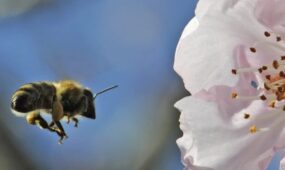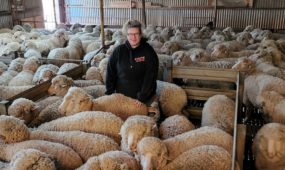Cool solution to heat stressed vines
Primary Industries
EVAPORATIVE cooling systems are being used in South Australian vineyards as part of a project to protect grapes during heat waves ahead of harvest

Sign up to receive notifications about new stories in this category.
Thank you for subscribing to story notifications.
The project is using under-canopy sprinklers in the Riverland and Coonawarra wine regions to cool vineyards at night during heat waves at the height of the Australian summer.
Principal Scientist with the South Australian Research Development Institute Mike McCarthy is leading the project, which is jointly funded by Wine Australia and the Federal Department of Agriculture and Water Resources.
Dr McCarthy said growers across Australia had reported severe impacts on fruit particularly after three or four consecutive days of scorching heat.
He said many growers believed hot nights were as much to blame as hot days for damage such as leaf scorch, reduction in grape quality and lower yields.
“The scientific basis of that is we were hypothesizing whether these hot nights meant the vines couldn’t fully rehydrate and regain their turgor overnight for the next hot day and that’s where it all really started,” Dr McCarthy said.
“At the same time we heard a few comments from some of the cooler regions that it was hot nights that was causing loss in varietal character in some varieties.
“We thought that if we could somehow cool these vineyards down at night perhaps we might see a positive effect in yield and wine quality.
“We’re now seeing heat warnings to the general public, the health authorities are saying people have to be able to cool themselves down at night to tolerate the next hot day so maybe there’s a bit of corollary with how human beings cope with hot weather and hot nights versus grape vines.”
The project started in 2014 with the selection of two test sites in the South Australian Riverland and one in the Coonawarra region.
However, a milder than average December and January a year ago meant the previous harvest was largely unaffected by hot weather before harvest.
Dr McCarthy said a hot summer this year, where Riverland daytime temperatures had reached 45C, had provided excellent conditions to conduct the trial.
The test sites use under canopy micro sprinklers to act as evaporative coolers while in the Coonawarra, frost protection sprinklers, traditionally used in winter, are also used. Canopy temperature and humidity measurements are taken regularly and different times of day.
The Riverland is Australia’s largest wine-producing region and the hottest in South Australia. It is about 250km northeast of the South Australian capital Adelaide on the banks of Australia’s largest river, the Murray. The Coonawarra is about 375km southeast of Adelaide and is a cooler climate region renowned for its high quality cabernet sauvignon.
Dr McCarthy said the sprinklers were “pulsed on and off” in short bursts over a 30-minute period three or four times on hot nights.
“It’s using the same principle as the evaporative cooling system that might be on your house – you’re evaporating water to get that cooling effect,” he said.
“Raising the humidity reduces the evaporative demand for water and we’re also wetting the whole of the vineyard floor so we’re cooling soil temperatures as well at night.”
Dr McCarthy said another factor was the shorter nights in December and January in Australia either side of the summer solstice, meaning vines had less hours of darkness to recover from the fierce daytime heat.
But he said a recent visit to the Riverland sites at the height of the Australian summer revealed the vines were looking healthier than at other vineyards in the area.
“The canopies were happier, there was more green leaf, less leaf scorch and the berries are definitely bigger where we’ve been pulsing the sprinklers on and off at night.
“There does appear to be a positive benefit in terms of yield, whether that translates through into wine we won’t know until the small lot wines are made later on in the year but visually the vineyards look better.”
“We started cycling these sprinklers on right back in October and the reason for that is that we know from wine chemists that a lot of the flavour precursors are actually synthesized between berry set and veraison so that period pre-Christmas is important too.”
According to the International Organization of Vine and Wine, Australia was the world’s seventh largest wine producing nation in 2015. Italy, France and Spain topped the list.
South Australia is consistently responsible for almost 50 per cent of Australia’s annual production.
Harvest in the Riverland sites will begin in the last week of January while the Coonawarra grapes are unlikely to be picked until late March.
Dr McCarthy said it was too early to say if the benefits of the cooling technique would outweigh the costs.
“One of the things we have to calculate at the end of the project is how much additional water have we used in cooling these vineyards down at night and the cost of that water versus the potential increase in yield or potential increase in wine quality.”
“There’s also a management issue – if you’ve got a very large vineyard is it going to be possible to turn sprinklers on and off on every single patch of grapes in that vineyard in a single night, probably not.
“So therefore growers are going to have to make some rational decisions about their most profitable blocks and their most profitable varieties.”
“If that fruit is worth many thousands of dollars a tonne then retrofitting a sprinkler system to cool the vineyards on those few but critical hot nights during the season I suspect would be highly profitable.”
Dr McCarthy said he had previously witnessed the use of similar evaporative cooling systems in orchards in Washington state in the United States to help retain colour in apples but believed it was the first time it had been deliberately targeted in the wine industry.
He said the yield benefits of the project would begin to be known in the coming weeks following harvest but the effect on the wine would not be known until a full sensory analysis had been completed towards the end of the year.
“If this concept does work then Wine Australia will have to think about how they will get the results out to the wider industry.”
University of Adelaide Oenology Professor Dennis Taylor said temperatures throughout the growing season had the potential to significantly impact on the quality and flavours of wine.
“Any project like this will lead to new discoveries and will certainly be of interest to those doing the research and also to the winemakers and viticulturalists,” he said.
Jump to next article



